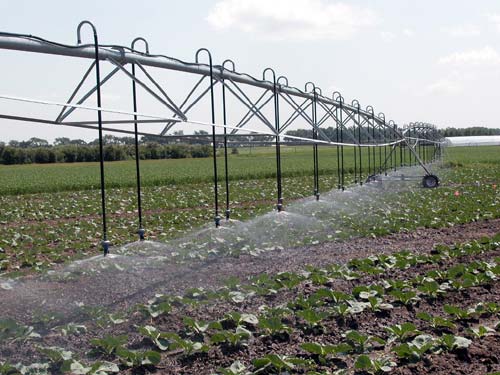|
Vegetable production is intensive, often requiring large inputs of water and nutrients.
The value of crops is high, and water has traditionally been regarded as a small component of the total growing cost.
This is changing, as demand increases for this scarce resource, and water shortages occur in vegetable growing areas. The vegetable industry currently lags behind other horticultural sectors in the understanding of plant water needs and irrigation best practices.
Irrigation benchmarking involves the collection of onfarm information about irrigation practices, crop performance and water use efficiency (WUE).
Irrigation benchmarking is a proven tool for increasing WUE. It allows growers to compare their performance at both local and national levels, as well as providing policy makers with sound information to use in setting realistic efficiency targets.
This report details the results of a pilot study conducted between July 2004 to September 2005, to benchmark water use in vegetable crops grown in two contrasting areas of Victoria:- peri-urban Melbourne (Cranbourne, Mornington Peninsula and Werribee) and the Mallee (Mildura and Swan Hill).


Key Findings :
-
Most participants used fixed sprinkler irrigation.
Crops included lettuce, broccoli and carrots near Melbourne, and carrots, pumpkins, squash and zucchinis in the Mallee.
-
Average marketable yields reported by growers ranged from 13.3 t/ha for broccoli to 50.8 t/ha for carrots around Melbourne, and from 8.1 t/ha for squash to 43.2 t/ha for carrots in the Mallee.
-
Average water use reported for the target crops ranged from 1.2 (in broccoli) to 3.3 ML/ha (in carrots) around Melbourne, and from 1.7 (in squash) to 3.1 ML/ha (in zucchini) in the Mallee.
-
Average crop water use efficiencies (measured as t/ML) varied from 9.2 (for broccoli) to 28.4 (for lettuce) around Melbourne, and from 2.3 (for pumpkin) to 24.5 (for carrots) in the Mallee.
-
The comparative results were of interest, but their accuracy and value were rightly questioned given the limited sample and obvious differences in cropping circumstances.

This study provides useful insights into some of the issues
facing farmers
in the irrigation of vegetable crops across Victoria.
Key Findings (cont):
- The application of water for environmental control – to germinate weeds, control wind-blown dust and sand, and to protect and maintain moisture under young seedlings. – arose as a significant consideration in some areas.
-
Over-watering also occurred when the output of a pump was too great for one block, necessitating the irrigation of other areas, whether they needed it or not. With an abundant supply of water, these issues have not been of concern to growers in the past.
-
Most growers were unaware of how much water per hectare they were applying. Water use efficiency was not seen as a high priority for many of these growers, but most saw it as becoming more important to them.
-
Most participants saw value in the information and were willing to take part in future benchmarking activities.
SEE ALSO :
VG08020 Optimising water & nutrient use (2010)
VG04010 Maximising returns from water – Victoria (2007)
Acknowledgements :
This project has been facilitated by the Victorian State Government and Horticulture Australia Limited (HAL)
in partnership with AUSVEG through the National Vegetable Research and Development Levy.
The Australian Government provides matched funding for all HALs R&D activities.
|


